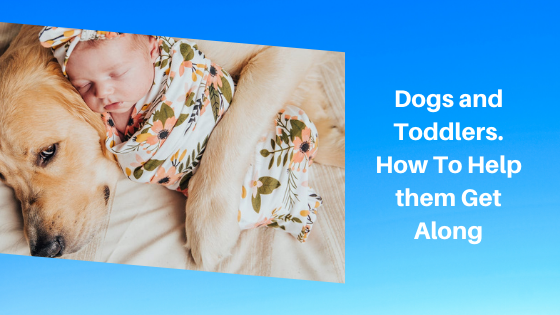Dogs and Toddlers. How To Help them Get Along
Posted by Jackie Ly on Sep 04, 2020

There are a lot of challenges that come with having a child. One of them is teaching them to get along with your family pet. While it’s natural for a young child to be scared of animals that they don’t understand; as they get older, they must learn to be comfortable living with them. It would be easy if your toddler quickly becomes your dog’s best friend, but this isn’t always going to be the case. Some children just won’t like dogs no matter what you do, however, we can always try our best to show them what we love most about our paw-some pals.
Toddlers are noisy, emotional, unpredictable, and sometimes incredibly frustrating. A new puppy can often exhibit the same behaviours, so getting them to work together can sometimes seem a huge task. The key to improving their relationship over time is safety. The last thing you want is your dog or toddle being fearful of one another. We’ve all heard stories of someone who had a scary experience with a dog when they were young, turning them off pups for life! If you want your pets and children to coexist peacefully, there are a few crucial strategies to start implementing right away.
Get your child comfortable with all dogs
The ultimate goal is for your toddler to develop a healthy relationship with all dogs, ensuring they see the best of them as an animal. To do this, they need to learn the rules when it comes to interacting with a stranger’s pet. Teach them to always check with you before approaching a dog, or at the very least, ask their owner first. Show them how to pat a dog gently, approach calmly from the side, and in their line of sight. Your kids learn from your behaviour, so make sure you practice what you preach!
When it comes to your pooch, make sure your toddler knows what’s okay and what isn’t. Leave your dog alone at feeding time and involve your child in caring for your pet whenever possible. You could let them brush their fur or change their water bowl with your supervision. Furthermore, your dog has a role to play too. Make sure they know how to socialise correctly with all other dogs and humans. Here are some tips on how to do this effectively.
Supervise them and give your dog space!
Toddlers, as well as puppies, can be extremely unpredictable. Usually, when something terrible happens to our children, it’s when we’re not watching. While we can’t be watching our child with an eagle-eye 24/7, there are sensible steps we can take while they are young. Instead of leaving your toddler alone with the family pet for even a moment, it’s better to take them with you instead. As you both grow more confident, this might be able to change, but it’s always better to play it safe at first.
“Your dog should never feel forced to spend time with your child.”
On the other hand, your dog should never feel forced to spend time with your child. They should always have the option to leave if they’re not feeling it, for whatever reason. When your child is throwing a fit, or otherwise exhibiting behaviour that might make your dog uncomfortable, it’s better to distract your pet with another task. Give them an interactive toy or bone to distract them instead!
Reinforce the great times they have together
Wherever possible, make sure that interactions between your pet and your child are both positive and recurring. A great way to do this is by giving them responsibilities for your dog’s care when they are old enough to do so. For example, while you’re all out on a walk, give your child some treats to dispense to your dog. Get them to help you identify doggy waste in the backyard, so you don’t miss a thing while cleaning. Similarly, reward your pet for having a safe and fun play session with your toddler. It’s all about making it rewarding to interact with each other.
Use a dog training e-collar in moderation
A dog training e-collar can be a great tool to prevent excessive barking, aggressive behaviour, and improve the results of training. Dog training collars use mild stimuli, such as a high-pitched sound, vibration, or mild-static to discourage unwanted barking and reinforce good behaviour. If you find your dog gets rowdy and excited around your little ones, you can switch your dog’s training collar on to help minimise overreactions and teach them to remain calm.
Over time, your dog will learn what you expect from them and the behaviour you find acceptable. This will also help your toddler become more comfortable around your playful pup. The greater understanding you all have of one another increases the chances of a happy, well-behaved pup and a toddler that equally appreciates the positives a dog can bring to your family.
A quality, well-calibrated dog training e-collar is an excellent and safe tool that can ensure living and connecting with your dog remains a stress-free experience throughout their entire life. Dog Gear offers trusted electronic dog training collars, utilising warning tones to prompt your pup safely. With free Australian shipping and same-day dispatch, our products will be with you fast. Follow us on Facebook for the latest advice, updates and dog training tips!
